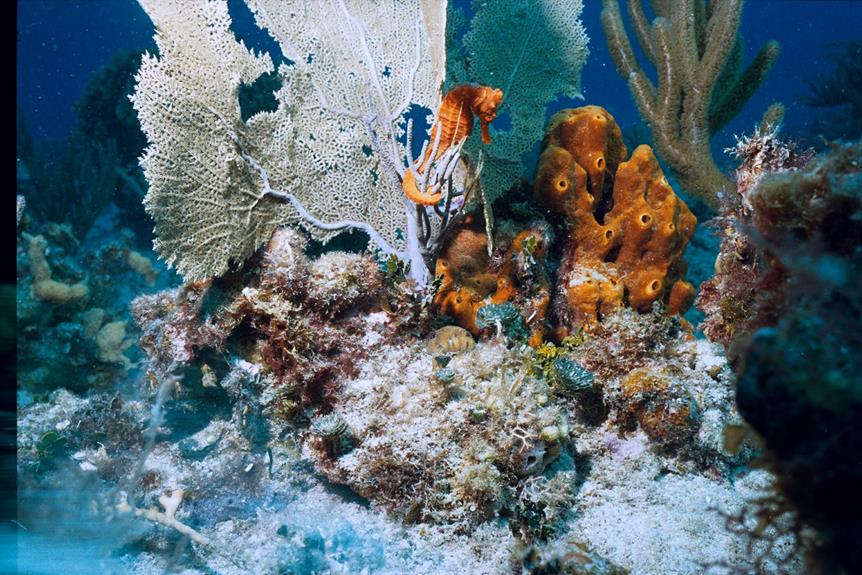When considering the aesthetic enhancement of your aquarium, the choice between water spangles and duckweed can be a pivotal one. Both plants bring a unique allure to aquatic landscapes, with water spangles boasting intricate leaf patterns and duckweed's minimalistic appeal.
Origin, growth patterns, and care requirements play significant roles in determining which plant will thrive and contribute to the overall beauty of your aquarium. As we delve into the intricacies of these aquatic plants, a clearer picture emerges of how each can transform your underwater world.
Key Takeaways
- Duckweed offers superior water-filtering properties and oxygenation benefits compared to Water Spangles.
- Duckweed plays a crucial role in controlling algae growth and enhancing overall water quality in aquariums.
- Water Spangles and Duckweed have distinct growth preferences and maintenance requirements for optimal beauty and health.
- Incorporating Duckweed in aquariums promotes a balanced ecosystem, benefiting aquatic life and enhancing habitat aesthetics.
Plant Characteristics
Analyzing the plant characteristics of Water Spangles and Duckweed reveals key distinctions in growth patterns, habitat preferences, nutrient requirements, and seasonal variations between the two species. Water Spangles exhibit rapid growth and thrive in still waters with high nutrient content. In contrast, Duckweed prefers slow-moving or stagnant water bodies with lower nutrient levels.
Water Spangles show seasonal variations in growth, with accelerated proliferation during warmer months compared to Duckweed, which can maintain steady growth throughout the year. Understanding these differences in habitat preferences and nutrient requirements is crucial for successfully cultivating these aquatic plants in aquariums or ponds. Careful consideration of these factors will help in creating a suitable environment for either Water Spangles or Duckweed to flourish.
Origin and Size
Understanding the origin and size differences between Water Spangles and Duckweed provides valuable insights into the evolutionary history and physical characteristics of these aquatic plants.
- Growth Rates: Water Spangles have fast growth rates, requiring regular pruning. Duckweed, on the other hand, needs careful monitoring of growth to control its spread.
- Habitat Preferences: Water Spangles originate from Central and South America, while Duckweed is found in Africa, Asia, Europe, and North America.
- Size Variations: Water Spangles can grow up to 0.6 inches, slightly larger than Duckweed, which reaches up to 0.4 inches.
- Geographic Distribution: Water Spangles are native to Central and South America, whereas Duckweed has a broader distribution across Africa, Asia, Europe, and North America.
- Conclusion: These differences in growth rates, habitat preferences, size variations, and geographic distribution play a significant role in determining the suitability of Water Spangles or Duckweed for your aquarium.
Color and Lighting Needs
When considering the color and lighting needs of Water Spangles and Duckweed, it is essential to understand their distinct requirements for optimal growth and visual appeal in an aquatic environment. Water Spangles typically exhibit a light green coloration, while Duckweed ranges from light to dark green hues. Both plants thrive under moderate to high lighting conditions.
Water Spangles' light green color preference enhances its aesthetic appeal, especially when illuminated adequately. Duckweed's varying shades of green also benefit from sufficient lighting to maintain vibrant pigmentation. Understanding and providing the appropriate lighting requirements will not only promote the plants' growth but also enhance the visual appeal of your aquarium, creating a harmonious underwater environment.
Care and Propagation Methods
Care and propagation methods for Water Spangles and Duckweed play a crucial role in maintaining these aquatic plants' health and growth in aquarium settings. When considering the care and propagation of these plants, specific techniques and methods are essential:
- Pruning techniques: Regular pruning is necessary for Water Spangles due to their fast growth rate.
- Growth control: Monitoring the growth of Duckweed is crucial to prevent it from taking over the aquarium.
- Asexual propagation: Duckweed reproduces through asexual vegetative propagation, making it easy to spread.
- Spore dispersal: Water Spangles reproduce by releasing spores in their native habitat, aiding in their propagation.
- Maintenance: Control water flow to prevent overcrowding and ensure optimal growing conditions for both Water Spangles and Duckweed.
Water Spangles Propagation
In the process of propagating Water Spangles, a key factor to consider is the method of spore dispersal for successful reproduction. Water Spangles reproduce through spores in their native habitat, allowing for rapid expansion in favorable conditions. Their growth rate is notable, with the potential to double or triple in size within 7-10 days under optimal circumstances.
To manage this fast growth, regular pruning techniques are essential. Additionally, controlling water flow in the aquarium can help regulate the spread of Water Spangles. By monitoring their propagation through spores and implementing appropriate care measures like pruning and water flow control, aquarists can effectively maintain and propagate Water Spangles in their aquarium.
Duckweed Propagation
Duckweed propagates primarily through asexual vegetative reproduction, a process that contributes to its rapid spread and growth in aquatic environments. This method of propagation allows duckweed to quickly colonize water surfaces, making it a common sight in ponds and other aquatic habitats.
Here are some key points about duckweed propagation:
- Duckweed reproduces by forming daughter fronds that detach from the parent plant.
- Each daughter frond can develop into a new individual plant under suitable conditions.
- Duckweed can rapidly cover the surface of ponds, providing shade and shelter for various aquatic organisms.
- The ability of duckweed to reproduce vegetatively enables it to thrive in diverse pond ecosystems.
- Efficient propagation ensures that duckweed can play a crucial role in nutrient cycling and oxygenation within pond environments.
Growth and Maintenance Tips
Efficient management of aquatic plant growth and maintenance is essential for sustaining a balanced ecosystem within ponds and aquariums. When it comes to water spangles and duckweed, understanding their growth rates and maintenance requirements is crucial.
Water spangles exhibit fast growth and require regular pruning to prevent overgrowth. On the other hand, duckweed necessitates monitoring of its growth and controlling water flow to prevent excessive spreading. Both plants thrive in favorable conditions, with water spangles capable of doubling or tripling in size within 7-10 days.
Maintaining optimal water quality is also vital for the well-being of these plants, as it directly impacts their growth and overall health. By implementing proper pruning techniques and water flow control, aquarists can ensure the healthy growth of water spangles and duckweed in their aquatic environments.
Water Spangles FAQs
Understanding the intricacies of water spangles through frequently asked questions is essential for successful cultivation and maintenance in aquatic environments.
- How fast do water spangles grow?
Water spangles can double and triple in size within 7-10 days in favorable conditions.
- What is important to know about water spangles growth?
They multiply quickly and need pruning to control their growth.
- Are there any predators that target duckweed?
Yes, duckweed can be eaten by predators like koi, grass carp, and goldfish in a pond.
- What are the benefits of duckweed in an aquarium?
Duckweed is a great water-filtering plant that oxygenates water, provides oxygen, and absorbs CO2, improving water quality.
- How can water flow be managed for duckweed maintenance?
It is important to monitor the growth of duckweed and control water flow to ensure optimal conditions for growth.
Duckweed Benefits
Enhancing aquatic environments, duckweed serves as a beneficial water-filtering plant that contributes to water quality improvement through oxygenation and CO2 absorption. In aquariums, duckweed benefits include its ability to oxygenate the water, providing a healthier environment for fish and other aquatic organisms. By absorbing CO2, duckweed helps maintain proper pH levels in the aquarium, promoting a balanced ecosystem.
Additionally, duckweed acts as a natural filter, removing excess nutrients and waste that can accumulate in the water. This plant's rapid growth also aids in controlling algae by competing for nutrients, thus reducing the likelihood of algae blooms. Overall, incorporating duckweed into aquarium filtration systems can significantly enhance water quality and support a thriving aquatic habitat.
Frequently Asked Questions
Can Water Spangles and Duckweed Be Used Together in the Same Aquarium?
Compatibility and maintenance of water spangles and duckweed in the same aquarium depend on factors like light, space, and nutrient availability. Both plants can coexist if properly managed, ensuring they don't overcrowd or outcompete each other for resources. Regular monitoring is key.
Are Water Spangles or Duckweed More Likely to Attract Pests or Insects?
In aquatic environments, duckweed is more likely to attract pests or insects due to its fast growth and ability to provide a habitat for small organisms. Regular maintenance, including controlling plant density, can help prevent pest issues in aquariums.
Do Water Spangles and Duckweed Have Any Specific Temperature Requirements?
Water spangles and duckweed thrive in a wide range of temperatures, making them adaptable to most aquarium environments. Both plants are compatible with various fish species and have moderate to high lighting needs, contributing to their rapid growth rates.
Are There Any Known Allergies or Sensitivities Associated With Handling Water Spangles or Duckweed?
When handling water spangles or duckweed, it's important to consider potential allergies or sensitivities to aquatic plants. While rare, some individuals may experience skin irritation or respiratory issues. Proper precautions, like wearing gloves, can help mitigate risks.
Can Water Spangles or Duckweed Be Harmful to Certain Types of Fish or Aquatic Animals in an Aquarium?
Compatibility concerns may arise with fish that graze at the water's surface due to the dense coverage created by water spangles or duckweed. Regular monitoring and tank maintenance are crucial to prevent overgrowth and ensure a healthy aquatic environment.
Conclusion
In conclusion, water spangles and duckweed offer distinct characteristics and care requirements for aquarium enthusiasts to consider.
Interestingly, duckweed is known to be one of the fastest-growing plants on earth, with some species doubling their biomass in just two days.
This rapid growth rate can have both benefits and challenges for aquarium maintenance, making it essential for aquarists to carefully monitor and manage their aquatic plant selection.





